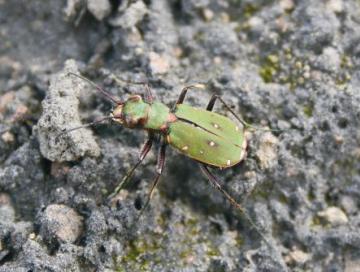Species Account for Cicindela campestris
PLEASE NOTE, many records in this group are not yet available
Cicindela campestris Linnaeus, 1758
Green Tiger Beetle
Coleoptera: Carabidae

Reproduction for study and non-profit use permitted, all other rights reserved.
Taxonomic group: beetles (Coleoptera) - Available county data
View time series maps for Cicindela campestris
member log-on for taxon report
Essex RDB: Listed
Images
upload a new image
Essex Red Data List comment
The Green Tiger Beetle is rare in Essex. Nationally it is found in areas with bare ground or sparse vegetation such as sandy heath, moorland, clay pits and quarry spoil heaps, always in sunny situations. Adults are active in early summer and will often take to the wing when disturbed. Both adults and larvae are predators on other invertebrates. The larvae form a burrow in the ground, often on or near paths. Widespread and common in some areas, very local in others. It is a good indicator for heathland management.
Species text
Although widespread on open, dry heaths and moors throughout Britain, many records shown in Luff (1998) are old. The tiger beetle Cicendela campestris is rare and threatened in Essex and neighbouring counties. It is an annual species, breeding early in spring, the larvae inhabiting vertical burrows in the soil. In Essex the only recent records appear to be from from Walton-on-Naze and Colchester (J. Bowdrey, 2001), a small area of Danbury Common, Linford Sand Pit (possibly now lost) and several other brownfield sites near the Thames in south Essex. There are earlier records from Epping Forest, Grays and Sandon. References
Habitats
Recorded management for locations with Cicindela campestris
Recorded substrate and hydrology for locations with Cicindela campestris
Why not join the Club, register and add a new species page
Interpretation of distribution maps

























